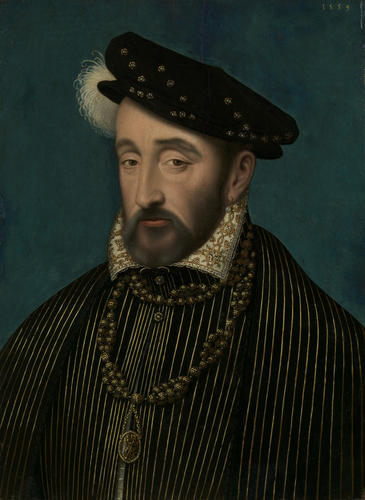-
1 of 253523 objects
Henry II, King of France (1519-1559) 1559
Oil on panel | 39.6 x 28.7 cm (support, canvas/panel/stretcher external) | RCIN 403430

Studio of François Clouet (c. 1520-1572)
Henry II, King of France (1519-1559) 1559
-
François Clouet was trained by his father and succeeded as peintre et valet de chamber to Francis I in 1540/41. He served Henry II after the death of Francis I in 1547, but he found more patronage from Catherine de Médicis, who collected his portrait drawings.
Henry II (1519-59) was the second son of Francis I and became heir to the throne when his elder brother died in 1537. He succeeded his father as King of France in 1547. He married Catherine de Médicis in 1533 when both were 14 years old. During his reign he pursued war with Charles V with the intent of recapturing Italy, but was ultimately defeated in Tuscany in 1553 at the battle of Marciano. He raised Mary, Queen of Scots at his court in the hope of securing a claim on Scotland and ultimately England. His son Francis was married to Mary in 1558. In 1559 the Peace of Cateau-Cambrésis was signed between France, Spain and England, but at the tournament to celebrate the treaty Henry was famously wounded in his eye by a lance and died. Henry continued his father’s patronage of art, architecture and literature, his reign being remembered particularly for ephemeral feats of display, such as his entrance into Rouen in 1550, which combined the skills of painters, sculptors and poets. His wife Catherine de Médicis was not only an important patron of the arts, but must have carefully managed the dissemination of the images of the late King after his death.
This is a high-quality head and shoulders of Henry II produced by Clouet’s studio, probably in the year of the King’s death. The King wears the insignia of the Order of St Michel, the French rival to the Order of the Garter and the Order of the Golden Fleece. There are many versions of this portrait, all dated 1559: the best known apart from the present work are in the collections at Versailles (perhaps the highest quality), the Louvre and the Palazzo Pitti, Florence. The preparatory drawing by Clouet has been dated c.1547 (Cabinet des Estampes, Bibliothèque nationale de France, Paris) and must have served as a prototype for the full-length portrait in the Galleria Palatina, Palazzo Pitti, Florence, and for the studio copies which replicate the head and shoulders in the Pitti portrait. Following restoration of the full-length Pitti portrait, it is now considered to be one of the most important official court portraits produced in France in the sixteenth century and is thought to be by Clouet himself. It was possibly painted when Henry became King in 1547. The King has the aristocratic elegance typical of court portraiture across Europe. Its formality is as close to northern portraiture by Anthonis Mor and Jakob Seisnegger as to the refined portraits by Italian artists such as Agnolo Bronzino and Francesco Salviati.
Three other Clouet drawings (British Museum, London, Hermitage, St Petersburg and Cabinet des Estampes, Bibilothèque nationale de France, Paris) are based on the Paris drawing and show the King beginning to advance in age, with a greying beard. The studio versions of his likeness, as here, show his beard beginning to go grey, but preserve the essential characteristics of the Paris drawing and the magnificent portrait in the Palazzo Pitti, Florence.
Catalogue entry adapted from The Northern Renaissance. Dürer to Holbein, London 2011Provenance
Purchased by George IV in 1817 from Mr Colnaghi for 42 guineas (RA/GEO/MAIN26999); recorded in the Middle Room upper floor at Carlton House in 1819 (no 176); taken to Windsor Castle
-
Creator(s)
Acquirer(s)
-
Medium and techniques
Oil on panel
Measurements
39.6 x 28.7 cm (support, canvas/panel/stretcher external)
52.7 x 42.0 x 4.9 cm (frame, external)
Category
Object type(s)